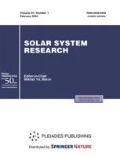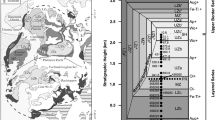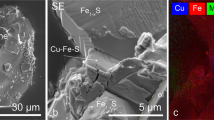Abstract
Layer-by-layer analysis of the fine fraction of Luna-16 sample L1635 by X-ray photoelectron spectroscopy (XPS) revealed a zonal structure of its constituent particles. The outer zone, to a depth of 1200 Å, is enriched with Si and Fe and depleted in refractory elements Mg, Ca, and Al as compared to the bulk composition of the sample. The second zone, in the depth range from 1200 to 4500 Å, is of very unusual composition: it is enriched with carbon (up to 60 at. %) and zinc (up to 4 at. %) and contains some other volatiles. The lower zone, at depths from 4500 to 7000 Å, is composed of a silicate material; however, the concentrations of refractory elements are noticeably higher than those in the near-surface layer. There is a difference in structural and chemical characteristics of most of the elements between different zones. These findings point to the exogenous origin of the enrichment of the studied sample with volatiles and are related to the fall of a volatile-rich body (comet or carbonaceous chondrite) on the Moon. The hypothesis of the cometary (carbonaceous-chondrite) impact explains the main patterns of the volatile distribution in the lunar regolith, including the formation of green and orange glasses from Apollo 15 and 17 collections.
Similar content being viewed by others
REFERENCES
Ahrens, T.J. and O'Keefe, J.D., Shock Melting and Vaporization of Lunar Rocks and Minerals, The Moon, 1972, vol. 4, pp. 214-249.
Anders, E., Ganapathy, R., Keays, R.R., et al., Volatile and Siderophile Elements in Lunar Rock: Comparison with Terrestrial and Meteoritic Basalts, Proc. 2nd Lunar. Sci. Conf., 1971, pp. 1021-1036.
Arndt, J., v. Engelhardt, W., Gonzales-Cabeza, J., and Meier, B., Formation of Apollo 15 Green Glass Beads, Proc. Lunar Planet. Sci. Conf. XV, J. Geophys. Res., 1984, vol. 89, Suppl., pp. C225-C232.
Arndt, J. and v. Engelhardt, W., Formation of Apollo 17 Orange and Black Glass Beads, Proc. Lunar Planet. Sci. Conf. XVII, J. Geophys. Res., 1987, vol. 92, Suppl., pp. E372-E376.
Bohsung, J., Arndt, P., Jessberger, E.K., et al., High Resolution PIXE Anasyses of Interplanetary Dust Particles with the New Heidelberg Proton Microprobe, Planet. Space Sci., 1995, vol. 43, nos. 3–4, pp. 411-428.
Briggs, D. and Seah, M.P., Eds., Practical Surface Analysis by Auger and X-Ray Photoelectron Spectroscopy, New York: Wiley, 1983.
Brow, R.K., XPS Study of Oxygen Bonding in Zinc Phospate and Zinc Borophospate Glasses, J. Non-Cryst. Solids, 1996, vol. 194, pp. 267-273.
Brown, G.M., Emeleus, C.H., Holland, J.C., and Phillips, R., Mineralogical, Chemical and Petrological Features of Apollo 11 Rocks and Their Relationship to Igneous Processes, Proc. Apollo 11 Lunar Sci. Conf., 1970, pp. 195-220.
Clanton, U.S., McKay, D.S., Waits, G., and Fuhrman, R., Sublimate Morphology on 74001 and 74002 Orange and Black Glassy Droplets, Proc. 9th Lunar Planet. Sci. Conf., 1978, pp. 1945-1957.
Delano, J.W., Apollo 15 Green Glass: Chemistry and Possible Origin, Proc. 10th Lunar Planet. Sci. Conf., 1979, vol. 1, pp. 275-300.
Delano, J.W. and Livi, K., Lunar Volcanic Glasses and Their Constraints on Mare Petrogenesis, Geochim. Cosmo-chim. Acta, 1981, vol. 45, pp. 2137-2149.
Delano, J.W., Pristine Lunar Glasses, Proc. Lunar Planet. Sci. Conf. XVI, J. Geophys. Res., 1986, vol. 91., Suppl., pp. D201-D213.
Delano, J.W., Apollo 14 Green Volcanic Glasses with a Compositional Memory of Melting Processes in the Lunar Mantle, Proc. Lunar Planet. Sci. Conf. XXVII, 1996, pp. 301-302.
Dikov, Yu.P., Bogatikov, O.A., Barsukov, V.L., et al., Some Features of the Main Element Conditions in Surface Layers of the Regolith Particles of the Luna Automatic Station Samples: X-Ray Photoelectron Spectroscopy Studies, Proc. 9th Lunar Planet. Sci. Conf., 1978, pp. 2111-2124.
Dikov, Yu.P., Bogatikov, O.A., Barsukov, V.L., et al., Chemical Peculiarities of Particle Surface Layers of Some Apollo 17 Regolith Samples, Proc. 10th Lunar Planet. Sci. Conf., 1979a, pp. 1491-1505.
Dikov, Yu.P., Brytov, I.A., Romashchenko, Yu.N., and Dolin, S.P., Peculiarities of Electronic Structure of Silicates, Moscow: Nauka, 1979b.
Dikov, Yu.P., Gerasimov, M.V., Yakovlev, O.I., and Wlotzka, F., High-Temperature Vaporization of Mg–Ca–Carbonate-Sulfate-Alumina Targets, Proc. Lunar Planet. Sci. Conf. XXVII, 1996, pp. 311-312.
El Goresy, A., Ramdohr, P., and Medenbach, O., Lunar Samples from Descartes Site: Opaque Mineralogy and Geochemistry, Proc. 4th Lunar. Sci. Conf., 1973a, vol. 1, pp. 733-750.
El Goresy, A., Ramdohr, P., Pavicevic, M., et al., Zinc, Lead, Chlorine and FeOOH-bearing Assemblages in the Apollo 16 Sample 66095: Origin by Impact of a Comet or a Carbonaceous Chondrite? Earth Planet. Sci. Lett., 1973b, vol. 18, pp. 411-419.
Epstein, S. and Taylor, H.P., The Isotopic Composition and Concentration of Water, Hydrogen, and Carbon in Some Apollo 15 and 16 Soils in the Apollo 17 Orange Soil, Proc. 4th Lunar Sci. Conf., 1973, pp. 1559-1575.
Flynn, G.J., Sutton, S.R., and Bajt, S., Trace Element Content of Chondritic Cosmic Dust: Volatile Enrichments, Thermal Alterations and the Possibility of Contamination, Lunar Planet. Sci. Conf. XXIV, 1993, pp. 495-496.
Fogel, R.A. and Rutherford, M.J., Magmatic Volatiles in Primitive Lunar Glasses: I. FTIR and EPMA Analyses of Apollo 15 Green and Yellow Glasses and Revision of the Volatile-assisted Fire-Fountain Theory, Geochim. Cos-mochim. Acta, 1995, vol. 59, pp. 201-215.
Fredericks, J.R., Gibson, E.K., and Hartmetz, C.P., Trapped Lunar Volcanic Gases within Apollo 15 Glass Spherules, Lunar Planet. Sci. Conf. XXII, 1991, pp. 409-410.
Gerasimov, M.V., Dikov, Yu.P., Wlotzka, F., and Mukhin, L.M., Laser Simulation of Equilibrium High-Temperature Vaporization, Lunar Planet. Sci. Conf. XXIII, 1992, pp. 407-408.
Gibson, E.K. and Moore, G.W., Volatile-rich Lunar Soil: Evidence of Possible Cometary Impact, Science, 1973, vol. 179, pp. 69-71.
Green, D.H., Ringwood, A.E., Hibberson, W.O., and Ware, N.G., Experimental Petrology of Apollo 17 Mare Basalts, Proc. 6th Lunar Sci. Conf., 1975, vol. 1, pp. 871-893.
Heiken, G.H., McKay, D.S., and Brown, R.W., Lunar Deposits of Possible Pyroclastic Origin, Geochim. Cosmochim. Acta, 1974, vol. 38, pp. 1703-1718.
Holland, P.T., Simoneit, B.R., Wszolek, P.C., et al., Carbon Chemistry of Apollo 14 Size-fractionated Fines, Nature Phys. Sci., 1972, vol. 235, no. 58, pp. 106-108.
Jessberger, E.K., Christoforidis, A., and Kissel, J., Aspects of the Major Element Composition of Halley's Dust, Nature, 1988, vol. 332, pp. 691-695.
Jessberger, E.K., Bohsung, J., Chakaveh, S., and Traxel, K., The Volatile Element Enrichment of Chondritic Interplanetary Dust Particles, Earth Planet. Sci. Lett., 1992, vol. 112, pp. 91-99.
Jewitt, D., Cometary Photometry, in Comets in the Post-Halley Era, Newburn, R. and Rahe, J., Eds., Dordrecht: Kluwer, 1991, pp. 19-65.
Kuhrt, E.K. and Keller, H.U., On the Importance of Dust in Cometary Nuclei, Earth, Moon and Planets, 1996, vol. 72, pp. 79-89.
Lascovich, J.C., Giorgi, R., and Scaglione, S., Evaluation of the sp2 /sp3 Ratio in Amophous Carbon Structure by XPS and XAES, Appl. Surface Sci., 1991, vol. 47, pp. 17-21.
Lascovich, J.C. and Scaglione, S., Comparison among XAES, PELS, and XPS Techniques for Evaluation of sp2 Percentage in a C:H, Appl. Surface Sci., 1994, vol. 78, pp. 17-23.
Laul, J.C., Morgan, J.W., Ganapathy, R., and Anders, E., Meteoritic Material in Lunar Samples: Characterization from Trace Elements, Proc. 2nd Lunar Sci. Conf., 1971, vol. 2, pp. 1139-1158.
Laul, J.C., Ganapathy, R., Morgan, J.W., and Anders, E., Meteoritic and Non-Meteoritic Trace Elements in Luna-16 Samples, Earth Planet. Sci. Lett., 1972, vol. 13, pp. 450-454.
Lawler, M.E., Brownlee, D.E., Temple, S., and Wheelocr, M.M., Iron, Magnesium, and Silicon in Dust from Comet Halley, Icarus, 1989, vol. 80, pp. 225-242.
Lezenga, G.A., Ahrens, T.J., Nellis, W.J., and Mitchell, A.C., The Temperature of Shock-compressed Water, J. Chem. Phys., 1982, vol. 76, pp. 6282-6286.
McKay, D.S., Clanton, U.S., and Ladle, G., Scaning Electron Microprobe Study of Apollo 15 Green Glasses, Proc. 4th Lunar Sci. Conf., 1973, vol. 1, pp. 225-238.
McKay, D.S., Grain Surface Features of Apollo 17 Orange and Black Glasses, Proc. Lunar Planet. Sci. Conf. XXIV, 1993, pp. 961-962.
Melosh, H.J., Impact Cratering: A Geologic Process, New York: Oxford Univ. Press, 1989. Translated under the title Obrazovanie udarnykh kraterov: geologicheskii protsess, Moscow: Mir, 1994.
Mitchell, A.C. and Nellis, W.J., Equation of State and Electrical Conductivity of Water and Ammonia Shocked to the 100 GPa (1 Mbar) Pressure Range, J. Chem. Phys., 1982, vol. 76, pp. 6273-6281.
Moore, C.B., Lewis, C.F., Lariver, J.W., et al., Total Carbon and Nitrogen Abundances in Apollo 12 Samples, Proc. 2nd Lunar Sci. Conf., 1971, pp. 1343-1350.
Nunes, P.D., Tatsumoto, M., and Unruh, D.M., U–Th–Pb Systematics of Some Apollo 17 Lunar Samples and Implications for a Lunar Basin Excavating Chronology, Proc. 5th Lunar Sci. Conf., 1974, vol. 2, pp. 1487-1514.
O'Keefe, J.D. and Ahrens, T.J., Shock Effects from a Large Impact on the Moon, Proc. 6th Lunar Planet. Sci. Conf., 1975, pp. 2831-2844.
O'Keefe, J.D. and Ahrens, T.J., Impact Flow and Crater Scaling on the Moon, Phys. Earth Planet. Interiors, 1978, vol. 16, pp. 341-351.
O'Keefe, J.D. and Ahrens, T.J., Cometary and Meteorite Swarm Impact on Planetary Surfaces, J. Geophys. Res., 1982, vol. 87, pp. 6668-6680.
Pillinger, C.T., Cadogan, P.H., Eglington, G., et al., Simulation Study of Lunar Carbon Chemistry, Nature Phys. Sci., 1972, vol. 235, no. 58, pp. 108-109.
Reid, J.B., Taylor, G.J., Marvin, U.B., and Wood, J.A., Luna-16: Relative Proportions and Petrologic Significance of Particles in the Soil from Mare Fecunditatis, Earth Planet. Sci. Lett., 1972, vol. 13, pp. 450-454.
Ringwood, A.E., Volatile and Siderophile Element Geochemistry of the Moon: A Reappraisal, Earth Planet. Sci. Lett., 1992, vol. 111, pp. 537-555.
Roedder, E. and Weiblen, P.W., Apollo 17 “Orange Soil” and Meteorite Impact on Liquid Lava, Nature, 1973, vol. 244, pp. 210-212.
Ryan, E.V. and Davis, D.R., Energy Partitioning in Catastrophic Collisions, Proc. Lunar Planet. Sci. Conf. XXV, 1994, pp. 1175-1176.
Sato, M., The Driving Mechanism of Lunar Pyroclastic Eruptions Inferred from the Oxygen Fugasity Behaviour of Apollo 17 Orange Glass, Proc. 10th Lunar Planet. Sci. Conf., 1979, pp. 311-325.
Schultz, P.H. and Shrnka, L.J., Cometary Collisions on the Moon and Mercury, Nature, 1980, vol. 284, pp. 22-26.
Schultz, P.H., Effect of Impact-induced Shear Heating on Vaporization and Melting, Proc. Lunar Planet. Sci. Conf. XXVI, 1995, pp. 1249-250.
Shevchenko, V.V., Lunar Record of Cometary Shower, Proc. Lunar Planet. Sci. Conf. XXVI, 1995, pp. 1287-1288.
Shevchenko, V.V., Giant Comets in Inner Solar System, Proc. Lunar Planet. Sci. Conf. XXVII, 1996, pp. 1195-1196.
Taylor, L.A., Mao, K.H., and Bell, P.M., “Rust” in the Apollo 16 Rocks, Proc. 4th Lunar. Sci. Conf., 1973, vol. 1, pp. 829-839.
Uhlmann, D.R., Onorato, P.I.K., and Scherer, G.W., A Simplified Model for Glass Formation, Proc. 10th Lunar Planet. Sci. Conf., 1979, vol. 1, pp. 375-384.
Vickery, A.M., Effect of an Impact-generated Gas Cloud on the Acceleration of Solid Ejecta, J. Geophys. Res., 1986, vol. 91, pp. 14139-14160.
Vickery, A.M. and Melosh, H.J., Melt Droplet Formation in Energetic Impacts, Lunar Planet. Sci. Conf. XXII, 1991, pp. 1441-1442.
Vinogradov, A.P., Preliminary Data on Lunar Soil Brought Back by the Luna-16 Automatic Station, Geokhimiya, 1971, no. 3, pp. 261-274.
Wanke, H., Blum, K., Dreibus, G., et al., Multielemental Analysis of Samples from Highland Breccia 66095: A Contribution to the “Rusty Rock” Consortium, Lunar Planet. Sci. Conf. XII, 1981, pp. 1136-1138.
Wetherill, G.W., Problems Associated with Estimating the Relative Impact Rates on Mars and the Moon, The Moon, 1974, vol. 9, pp. 227-231.
Author information
Authors and Affiliations
Rights and permissions
About this article
Cite this article
Dikov, Y.P., Ivanov, A.V., Wlotzka, F. et al. The Nature of Volatiles in the Lunar Regolith. Solar System Research 36, 1–11 (2002). https://doi.org/10.1023/A:1014297009479
Issue Date:
DOI: https://doi.org/10.1023/A:1014297009479




